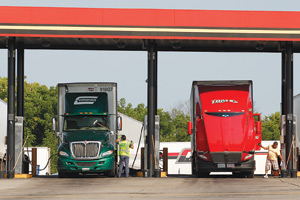Diesel Average Dips 0.2¢ to $2.615 in 12th Consecutive Weekly Decline

The average price of diesel fuel in the United States declined 0.2 cent a gallon to $2.615, the 12th straight weekly decline, the Department of Energy reported Aug. 17.
The national average for trucking’s main fuel was $1.22 a gallon cheaper from a year ago, DOE’s Energy Information Administration said after its weekly survey of fueling stations.
Diesel prices now are comparable to what they were in October 2009, according to the agency.
The cumulative value of the 12-week falloff is worth 29.9 cents since May 25. Retail prices for fuel declined in all major regions of the country except the Midwest, where it increased 2.4 cents.
“I’m just happy to see lower fuel prices,” Clay Handy, president of Handy Truck Lines in Paul, Idaho, told Transport Topics. “[The decline] has been really good for the industry, and I think it will help clean out some of the older trucks that we’re running and it will give everybody a shot in the arm that way,” Handy said.
He said he plans to replace more of the company’s older trucks than usual this year because of the improved bottom line due to lower diesel prices.
“I’m hoping eventually we’ll see some of that lower oil cost in a little better pricing for tires and lubricants and some of the other things that are petroleum-based,” he said.
The 125-truck general commodities carrier said that as the price of diesel has declined the return on some investments has changed including for fuel additives to increase fuel economy.
“We don’t do a lot of that, but I sure do hear a lot of sales pitches about it,” Handy said of fuel additives.
Gasoline rose for the first time in five weeks, increasing 8.7 cents to $2.716. The price jumped 31.6 cents in the Midwest, 3.7 cents in the Rocky Mountain region and 0.2 cent in the West Coast. The price was flat in the Gulf Coast.
According to news reports, leaking tubes on a piece of equipment forced BP to shut the largest crude unit at its Indiana refinery near Chicago on Aug. 8-9. The facility could be down for at least a month.
The closure puts extra oil into a market that already is oversupplied and cuts the supply of gasoline to the Midwest while summer demand still is high, Bloomberg News reported.
“It’s such an important refinery smack in the middle of the Midwest,” said Phil Flynn, senior market analyst at Price Futures Group in Chicago. “It’s like dropping a bomb in
Chicago and watching the shock waves ripple out to the rest of the country.”
The refinery can process as much as 270,000 barrels a day of heavy crude sent by pipeline from Alberta, with additional supply shipped up from Cushing, Oklahoma, the U.S. storage hub, Bloomberg reported.
In addition to the closing of the BP facility, other refiners will begin to close as part of planned seasonal maintenance.
“I think in particular when you ask about diesel prices, you have to keep in mind that we’re basically about ready to go into fall maintenance programs, where they take refineries offline to do work, and that during that time period, you can have a little tighter supply picture,” said Gene McGillian, am analyst with Tradition Energy.
Crude oil plunged to the lowest level in more than six years on the New York Mercantile Exchange after a government report showed that U.S. crude stockpiles unexpectedly increased, Bloomberg reported.
EIA said crude supplies rose 2.62 million barrels for the week of Aug. 10. An 820,000-barrel stockpile decline was projected by analysts.
West Texas Intermediate crude for September delivery dropped $1.82 to close at $40.80 a barrel on the Nymex on Aug. 19, the lowest settlement since March 2, 2009.
“You have two other factors that are weighing on oil prices which are helping to drive fuel prices lower, and that is the strength of the dollar [backed by the idea that the Fed will begin to lift interest rates] and also the idea that we will see new barrels of oil on the market from Iran. So all of these factors together have basically wiped out our spring rally, and now we are trying to find a bottom to this slide that started late last year,” McGillian said.
On Aug. 19, analysts at Citigroup speculated that the 2008 crude price of $32.40 a barrel in the United States is “a conceivable reality.”
The price of crude oil could fall below producers’ operating costs because shutting down production is such a costly maneuver that could be permanent, according to Citigroup.




